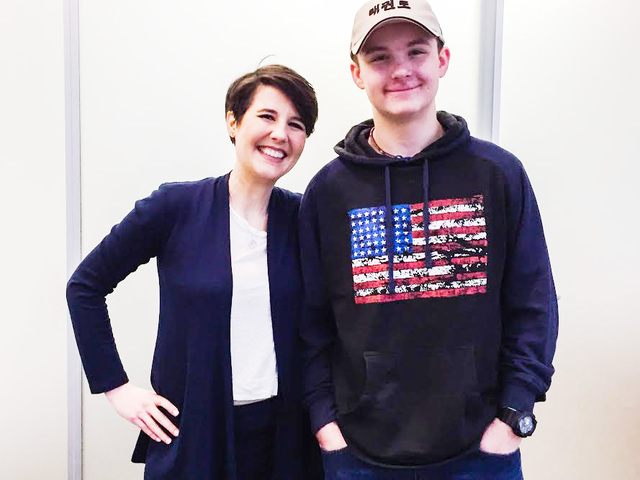Editor’s note: this is the first installment of Tyler Stewart’s journey to coping with migraines with the help of Emily Law, a psychologist at Seattle Children’s Pain Medicine program and a researcher at Seattle Children’s Research Institute. Part two will be printed in the 3/30 edition of the Courier-Herald.
Imagine being a kid, you go to school, play sports and spend time with your friends and family.
Now imagine growing up, being a kid and also having to learn how to deal with migraines.
That’s what happened to Tahoma High School sophomore Tyler Stewart.
He was just 5 years old when he got his first migraine.
Migraines are described as chronic headaches that occur 15 or more times a month.
Tyler’s mom, Kelly Stewart, said when he was in kindergarten, he would get headaches so bad he would vomit.
Kelly said the vomiting would relieve Tyler of the pain, but as he got older his migraines got worse and more frequent.
Now at 15 years old, Tyler is learning tools and ways to help him better manage his migraines.
“If it’s been available, Tyler has done it,” Kelly said in regards to migraine treatments and medications.
There were times when Tyler was taking a total of nine pills a day to help with his migraines.
“I began to hate taking medicine,” he said. “I even hated taking Advil because it was just another pill to take.”
Even though he is needle-phobic, Tyler tried acupuncture to help lessen the pain caused by migraines.
Kelly said she was in “panic mode as a parent,” trying to advocate for her son. But now Tyler has learned the tools to advocate for himself, Kelly said.
It was becoming a domino effect, she said. Tyler would miss days of school, get behind and then become stressed, which would lead to more headaches.
Stress is a key trigger for Tyler that causes his migraines. Other triggers of his, he said, are seasonal and his diet, but most of the time he doesn’t know what causes them.
For example, summer is the time of year Tyler said he has the least amount of headaches.
Seattle Children’s Hospital
Tyler had been going to Seattle Children’s Hospital Neurology department since he was 7 years old.
But last June, he tried something new.
He met with Emily Law, a psychologist at Seattle Children’s Pain Medicine program and a researcher at Seattle Children’s Research Institute.
Tyler spent time with Law learning how to “retrain (his) body to live life without pain,” he said.
He said one time while he was at Trampoline Nation, he got one of his worse migraines yet. He felt sick and couldn’t move.
After that incident, he didn’t want to go back because he had a negative connection with Trampoline Nation, now associating it to migraines.
Law told Tyler he needed to return to Trampoline Nation and when he did, he needed to go back with a migraine.
He went back twice and was able to trick his body that the pain he felt associated with his migraine was not going to harm him.
This same method could also be used with going to school.
As a freshman, Tyler missed 56 out of 180 days of school.
So far this year, he has only missed six, Kelly said.
“Without even noticing,” Tyler said. “I was teaching my body that school is an OK place to be.”
With chronic pain including migraines, Law said, our bodies are not sending the correct pain signals. Not all pain is dangerous to ourselves. She said when you stub your toe, break an arm or touch a hot stove there are clear start and stopping points and our bodies know what is causing the pain.
Because chronic pain is different, Law said you have to work to teach yourself the pain may be uncomfortable from a migraine but it will not harm you.
Biofeedback Program
Also during his time at Children’s, Tyler completed the Biofeedback Program with Law.
During this program, Tyler used memories and relaxation methods as a way to reduce the pain associated with migraines.
While he was doing this, Tyler was also connected to sensors that allowed him to watch his heart rate, temperature and breathing patterns.
“Biofeedback is one of the coolest things I’ve ever done,” Tyler said.
Tyler said Law wanted him to imagine a place or memory and walk back through it.
He added that she “literally meant walking through it.”
During his memory of choice, Tyler would use all five senses and connect those to his thoughts.
What did it smell like, what did he feel and see are all things Tyler incorporated into his memory.
He said after walking through his memory during biofeedback, he would come out, “so relaxed…. It’s like inception. You’re in another world, it’s very cool.”
While hooked up to sensors, Tyler said during biofeedback he can control his heart rate, temperature in his hands, his stress level along with blood pressure.
Since working with Law, Tyler said he has been able to reduce the number of migraines he gets. He said, he has gone from one a day to one every two to three weeks.
These methods don’t solve every headache, he said, but he has been given the tools to help reduce the number of migraines and the intensity.
“Dr. Law really empowers them to take hold of their lives,” Kelly added.
Law’s strategies and tools gave Tyler the ability to change his thoughts and feelings.
“(They) gave him more control over pain and allowed him the ability to do things despite the pain,” Law said. “(We were) working toward how to live a normal life.”
Tyler is still on daily medications but it is significantly less now that he has other ways of coping with migraines.


